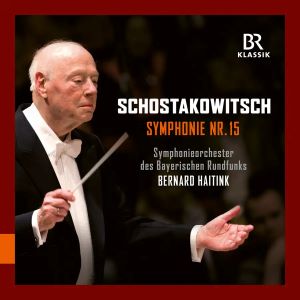
Dmitri Shostakovich (1906-1975)
Symphony No. 15 in A major Op. 141 (1971)
Symphonie-Orchester des Bayerischen Rundfunks/Bernard Haitink
rec. live, 5 & 6 February 2015, Philharmonie im Gasteig, Munich, Germany
Booklet with notes in German and English.
BR Klassik 900210 [46]
Bernard Haitink now has at least three recordings of this symphonic swansong in the catalogue. The 1978 one with LPO in his Decca cycle is also available separately. The 2010 live one was captured on an SACD with the Amsterdam Concertgebouw Orchestra on its own label. This BRSO version records a 2015 live account.
The three recordings are very similar, not least in timing. Even the longer second and fourth movements are remarkably consistent across the years. This is a conductor in different halls with different orchestras and in different decades who has retained an iron sense of pulse in this elusive work. The score suggests “Duration 45 minutes approx.”. When Maxim Shostakovich, who conducted the premiere in his father’s presence in Moscow in January 1972, recorded it live in Prague in 2006, the timings were 43:16 and 7:56/14:33/4:20/16:27.
| Total | I | II | III | IV | |
| LPO | 45:37 | 8:00 | 16:28 | 4:12 | 16:57 |
| Amsterdam | 45:54 | 8:32 | 15:56 | 4:25 | 17:01 |
| Munich | 47:13 | 8:17 | 16:46 | 4:21 | 17:49 |
Yet if there is relatively small scope for tempo variation between performances, there is plenty of room for varied interpretation in the non-musical sense. The many quotations and the playful, sombre, and enigmatic moods of portions of the score have given rise to various explanations of the work’s meaning. Mostly they do not help that much, as in the claim that the first movement takes place in a toyshop at night, which Antal Doráti discovered in an early Russian issue of the work. The quotation of the galop from Rossini’s William Tell Overture might indeed reference Shostakovich’s fondness for anapaest rhythms (as heard in the first movement before Rossini’s notes arrive). Yet five times in the eight-minute opening Allegretto makes the joke wear thin. Haitink somehow makes them sound inevitable and natural, as he does the whole movement. Quotes from Wagner’s Ring and Tristan und Isolde in the finale sound more coherent perhaps, and lend a fateful gravitas to proceedings.
Bernard Haitink integrates these elements very well, but what impresses most in this performance is the concentration achieved when there is so often very little on the page. There are two or three quiet lines in movements two and four, yet the tension is always maintained, born of perfect balance and scrupulous attention to the often restrained, yet nor unvarying, dynamics. There is effect enough when louder, more assertive music occurs, even if other conductors make still more of such moments. The excellent BRSO provide fine playing, and solos such as those for cello and later double bass in the funereal second movement are immaculate in execution. The closing tick-tock coda leaves us, as it should, with a sense of a puzzle that remains unsolved, but that hints at an intriguing if enigmatic future.
The booklet has brief but good notes, in German and English, on the music, conductor and orchestra. The recorded sound is very good as usual with BR Klassik live recordings, even if the widely praised Concertgebouw SACD mentioned above will be preferred perhaps by hi-res collectors. But I doubt that the work has had many finer guides through its riddling progress than the Dutch maestro.
Roy Westbrook
Buying this recording via a link below generates revenue for MWI, which helps the site remain free




















